Enhancing Space with Business Bay Partitions
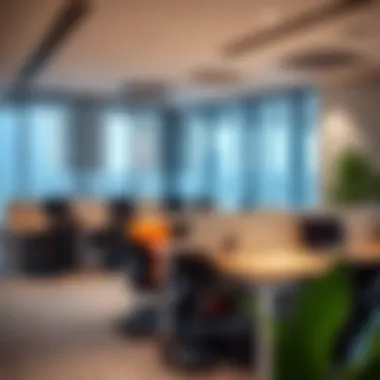
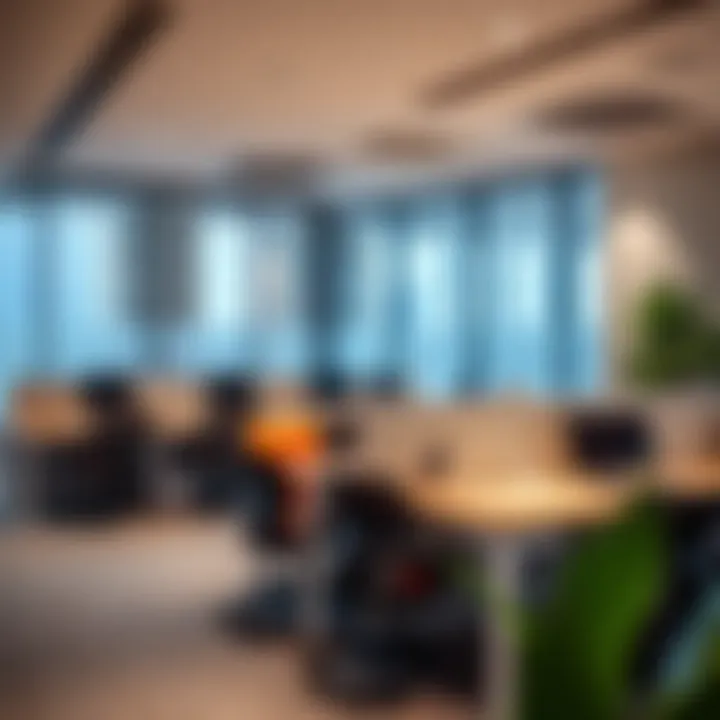
Intro
In the heart of Dubai, Business Bay stands as a bustling hub, attracting businesses and residents alike. This area is not just a mosaic of developments; it symbolizes dynamism and modernization. As the streets brim with entrepreneurial spirit, the design and aesthetics of workspaces have become crucial for maximizing functionality. One fundamental element in achieving this is through the effective use of partitions. This article takes a closer look at how partitions help in utilizing space efficiently, offering privacy while adding a unique touch to the overall aesthetics of an office or residential area.
From sleek glass dividers to modular wall systems, there are numerous possibilities to explore when it comes to partitions. Each variety serves not only a practical purpose but also plays a role in fostering collaboration among teams. In this detailed guide, readers can expect to find a wealth of information ranging from current trends in Dubai’s real estate market to sustainability aspects and future design considerations.
Market Insights
Current Trends in Dubai Real Estate
Business Bay is witnessing significant shifts in its real estate landscape. The demand for flexible working environments has surged, and with it, the inclination towards using partitions creatively has increased. Developers are recognizing that potential tenants often prioritize functionality over size. Trendy co-working spaces are on the rise, and they often employ partitions to create an adaptable work atmosphere. It’s not just about how much area one has but how well it can be optimized. Many are now leaning towards minimalistic designs that incorporate greenery and natural light, promoting worker wellbeing.
Another notable trend is the rise of mixed-use developments. These projects integrate residential, commercial, and leisure spaces within strikingly designed complexes. Here, partitions contribute significantly to defining spaces and enhancing the living experience while ensuring that areas are not just aesthetically appealing but functional too.
Investment Hotspots and Opportunities
Investors in Business Bay will find lucrative opportunities as the region continues to evolve. The rise in demand for commercial properties amidst a backdrop of impressive developments makes it a go-to spot for potential increases in property value.
- Commercial Real Estate: Projects like Dubai Water Canal and others signify the direction of the market.
- Residential Spaces: Residential developments that cater to expatriates and young professionals are flourishing, thanks to their proximity to major business districts.
- Tech-Driven Developments: Many investors are focusing on incorporating smart technology within partitions, enhancing utility and appeal.
The opportunities don’t just stop at being merely a property investor; the area also attracts entrepreneurs looking to establish start-ups and co-working environments. This creates a cycle where good partition design feeds into an enhanced work environment and subsequently encourages more people to flock to the area.
"Effective partitioning transforms mere square footage into dynamic spaces, enhancing productivity and collaboration."
Understanding Business Bay
The topic of Understanding Business Bay is crucial for anyone looking to navigate this urban landscape effectively. Business Bay, located in the heart of Dubai, is not merely a collection of skyscrapers and offices; it represents a hub of activity and opportunity, presenting a complex interplay of needs and features that can significantly impact the orientation of commercial spaces. Whether one is an investor, homebuyer, agent, or developer, grasping the essence of this area helps to identify the potentials and pitfalls that can affect decisions related to space utilization and design.
Overview of Business Bay
Business Bay stands out as an ambitious endeavor aiming to create a business district akin to the likes of Manhattan and the City of London. With towering structures and innovative architectural designs, this area is designed specifically for commercial and residential purposes, offering a mix that attracts multinational companies and thriving startups alike. Considered one of Dubai's most dynamic areas, it demonstrates the emirate's commitment to modernity and business growth.
A stroll through Business Bay reveals its planned infrastructure with smart connectivity and amenities designed for professionals and visitors. Office buildings, waterfront views, and green spaces coexist harmoniously, allowing for an inviting atmosphere amidst the urban hustle. The proximity to landmarks like the Burj Khalifa further enhances the area's allure, making it a prime location for businesses that wish to stand tall both literally and figuratively.
The Importance of Space in Urban Environments
Space in urban environments like Business Bay is not just a matter of square footage; it's about how that space is utilized. Effective spatial planning directly correlates to productivity and employee satisfaction, making it a focal point for businesses large and small.
In dense urban settings, where each meter counts, the sophistication of interior arrangements can change the dynamics of work. Well-optimized spaces can foster collaboration, encourage creativity, and ultimately drive business success. This translates into how partitions are designed and implemented in offices, their material choices, and their configurations.
"In urban jungles, mastering space is like mastering time: it can either bind you or set you free."
Moreover, understanding the impact of space extends beyond aesthetics. As our world grapples with remote working and emerging trends like hybrid office models, recognizing how to efficiently manage both shared and private spaces through partitions becomes a necessity. Companies need flexibility as they adapt to shifting demands, thus making it imperative to grasp the underlying characteristics of Business Bay and its spatial advantages.
The Role of Partitions in Commercial Spaces
Partitions play a critical role in the design and organization of commercial spaces, especially in bustling urban environments like Business Bay. They do much more than divide an area; they influence workflows, enhance aesthetics, and nurture a positive work culture. As businesses seek to maximize the utility of their spaces, understanding partitions becomes imperative for success.
Defining Partitions
Partitions can be defined as physical structures used to divide a larger space into smaller, more functional areas. These structures vary widely, from movable walls that can be adjusted on-the-fly to more permanent fixtures that boast durability and aesthetic appeal. In contemporary commercial spaces, partitions not only fulfill practical purposes but also express the company’s identity, atmosphere, and ethos. They are a solid solution to achieve efficient usage of limited space while maintaining a cohesive look throughout the workplace.
Benefits of Using Partitions
Partitions offer a wealth of advantages that contribute to improving overall office functionality:
Space Optimization
At the heart of any bustling office is the need for effective use of space. Space optimization through partitions allows a company to tailor its environment based on specific activities and needs. Instead of sprawling layouts that can waste valuable square footage, partitions foster a segmentation approach, leading to more strategic use of every inch. They can transform large, open areas into functional zones designated for various tasks—be it private meetings, collaborative work, or quiet concentration. This versatility is a mainstay for many professionals who find it much easier to focus when the environment is conducive to their work style, thereby boosting productivity.
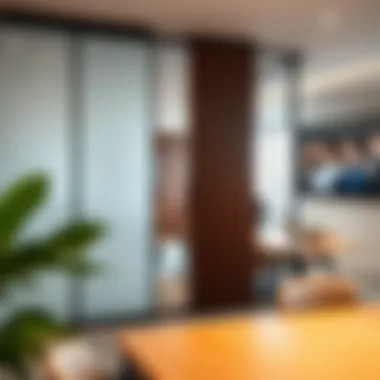
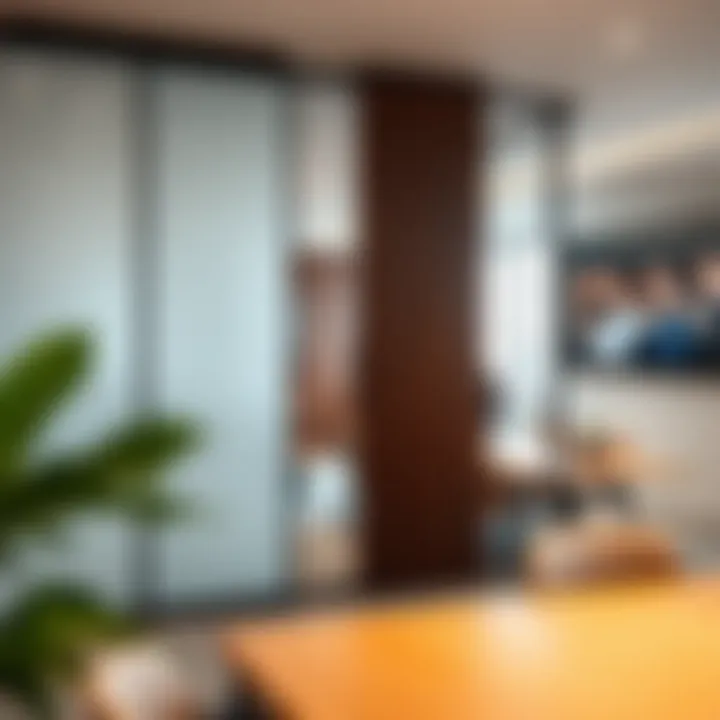
Enhanced Privacy
Privacy is a key concern in any workplace, particularly where sensitive discussions and brainstorming take place. Partitions contribute significantly to enhancing privacy by creating secluded areas that limit interruptions. For instance, offices might install wall dividers or soundproof partitions to guard against eavesdropping or distractions. This arrangement is not only beneficial but can also be a popular choice for businesses that prioritize confidentiality. The ability to have dedicated spaces for meetings ensures that teams can converse freely without the worry of being overheard—fostering a culture of trust and open communication.
Noise Reduction
In an environment where multiple activities occur simultaneously, noise can become a considerable distraction. Noise reduction facilitated by partitions addresses this issue head-on. Acoustic partitions, in particular, are designed to absorb sound, significantly minimizing echoes and reverberation. This creates a more pleasant environment for employees, which directly correlates to improved satisfaction and efficiency. Furthermore, the distinct feature of sound-absorbing materials can be aesthetically integrated into the design, making noise reduction both functional and visually appealing.
"Effective use of partitions not only influences physical layout but also creates a harmonious atmosphere that fosters collaboration and creativity."
In summary, the role of partitions in commercial spaces is multifaceted, encompassing various aspects such as workspace optimization, privacy enhancement, and noise management. Each benefit works synergistically to create a productive and appealing work environment, positioning businesses in Business Bay to thrive in their pursuit of success.
Types of Partitions Available
Understanding the various types of partitions is crucial for optimizing commercial spaces in Business Bay. Given the eclectic mix of businesses operating in this vibrant area, the choice of partition can significantly affect both function and aesthetic appeal. Choosing the right type of partition can also enhance collaboration and productivity while ensuring privacy and reducing noise. Let’s take a moment to explore the distinctive characteristics of each type of partition widely used in commercial settings.
Movable Partitions
Movable partitions are a versatile solution for dynamic commercial environments. Unlike fixed partitions, they can be rearranged easily, allowing businesses to configure their spaces as needed. This flexibility is invaluable, especially for companies that need to adapt their layouts for different projects, meetings, or events.
- Benefits of Movable Partitions:
- They allow for quick reconfiguration of space.
- They can accommodate changing employee needs without major renovations.
- Installation and dismantling are relatively straightforward, requiring minimal downtime.
One popular example of movable partitions is accordion walls, which can be folded and stored away when not in use, freeing up floor space for larger gatherings. Another type often seen in function-heavy designs is sliding panels; they offer more than just separation; they provide aesthetic creativity and can blend seamlessly with the office décor.
"The adaptability of movable partitions speaks volumes in a rapidly changing business landscape."
Fixed Partitions
Fixed partitions, as the name suggests, provide a more permanent solution to space division. Generally installed using frameworks fixed to the floor and ceiling, these partitions create stable walls that are ideal for long-term use. Companies with clear plans for space utilization may prefer this option for its durability and aesthetic stability.
- Considerations for Fixed Partitions:
- They typically offer better sound insulation compared to their movable counterparts.
- Fixed partitions can be built using a variety of materials, allowing businesses to customize the look and feel according to their brand.
- These walls often support heavier structures, such as shelves or cabinets, making them practical as well.
While less flexible than movable partitions, they provide a solid environment that works well for private offices, meeting rooms, and areas that require undisturbed focus.
Glass Partitions
The rise of glass partitions signals a significant design trend focused on transparency and openness. Primarily used in modern offices, these partitions combine aesthetic appeal with function; they allow natural light to permeate the workspace while visually expanding the area.
- Advantages of Glass Partitions:
- They maintain a sense of openness, making spaces feel larger and more welcoming.
- Sound transmission can be managed using specialized acoustic glass, providing both transparency and privacy.
- They can be easily customized with frosted or printed glass for added privacy without sacrificing light.
Glass partitions can create stylish conference rooms or collaborative workspaces that encourage creativity. Their sleek design often aligns with contemporary branding, giving businesses a cutting-edge image.
Acoustic Partitions
Finally, acoustic partitions are essential in environments where noise control is a priority. These partitions are specially designed to absorb sound and reduce distractions, making them perfect for busy offices, call centers, or creative spaces requiring focus.
- Characteristics of Acoustic Partitions:
- They come in various materials specifically engineered to block sound transmission.
- Acoustic panels can be added to existing partitions or designed as standalone structures.
- Aesthetically, they can be finished in numerous ways, from fabric-wrapped panels to minimalist wood designs.
In today’s diverse workplaces, ensuring minimal distraction while fostering productivity is paramount. Acoustic partitions ensure that employees can concentrate with reduced interruptions, benefiting overall work output.
Links for further reading:
- Wikipedia on Partitions
- Sustainable Design in Office Spaces
- Reddit Discussions on Office Design
- Government Regulations for Commercial Spaces
- Educational Resources on Business Architecture
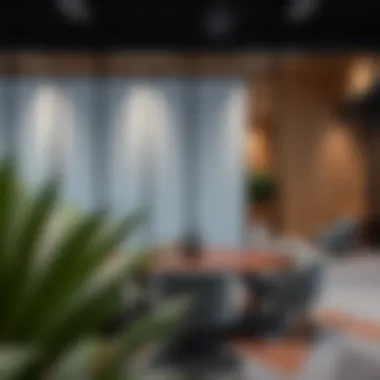
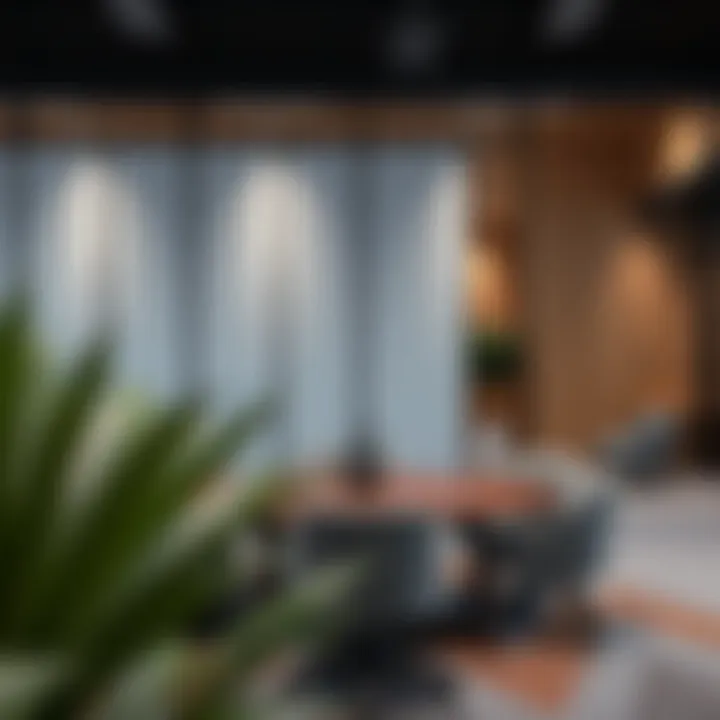
Design Considerations for Effective Partitions
When it comes to creating an effective workspace, partitions are more than just dividers; they are essential elements that can greatly influence both functionality and aesthetics in Business Bay. In a thriving business environment, where every square meter counts, the design of partitions becomes paramount. A thoughtfully designed partition can foster productivity, enhance collaboration, and ensure that the space is utilized to its utmost potential.
While the physical structure of partitions is crucial, the way they pair with branding, accommodate human needs, and adapt to changes is equally significant. Let's break this down into three major considerations that shape innovative partition use in Business Bay.
Aligning with Company Branding
Every office space tells a story, and its partitions should echo that narrative. The design of partitions should not only serve functional purposes but also be in line with the brand identity. A tech firm, for instance, may want sleek, modern glass partitions that convey transparency and innovation. In contrast, a law firm might favor more traditional, solid partitions that denote authority and professionalism.
- Key elements to consider:
- Color schemes: Choosing hues that align with corporate colors.
- Material selections: Using materials that reflect the ethos of the business. For example, reclaimed wood suggests sustainability, while metal can imply modernism.
- Visual branding: Incorporating logos or brand motifs directly on the partition surfaces.
In essence, when partitions resonate with the company branding, they create a cohesive environment that enhances employee morale and client perception. It's akin to dressing for success—when the atmosphere reflects the values of the firm, it can facilitate better business outcomes.
Human-Centric Design Principles
Designing with the user in mind is central to effective partitioning. Human-centric design considers the needs, preferences, and behaviors of employees, leading to a more comfortable and productive environment. Understanding how individuals interact with space can lead to effective partition layouts that promote well-being and efficiency.
A few important principles include:
- Natural light: Utilizing glass partitions to allow natural light to flow through spaces, thereby uplifting mood and productivity.
- Collaboration spaces: Creating nooks within partitions that encourage teamwork, rather than isolating employees from one another.
- Privacy provisions: Incorporating sound-dampening materials to ensure that sensitive discussions can happen without disturbance.
By focusing on human needs, businesses can increase employee satisfaction. After all, a comfortable setting is likely to result in a more engaged and inventive workforce.
Maintaining Flexibility and Adaptability
In today's fast-paced world, the ability to pivot is a must. The business environment is continually evolving, and so should the spaces we work in. This is where the design of partitions can be a game changer. Flexibility in partition design allows businesses to transform their spaces according to current needs without undergoing complete renovations.
- Movable partitions: These allow spaces to be reconfigured easily, adapting to changing team sizes or project requirements.
- Modular solutions: Using modular partitions that can be easily expanded or relocated.
- Integration of technology: Smart partitions that incorporate technology, such as projection screens or interactive displays, can easily be modified to serve various purposes.
By embracing a flexible mindset in design, companies can efficiently respond to changes and optimize their space for every unique requirement. This adaptability ensures longevity in workspace functionality, allowing businesses to weather changes seamlessly.
"In a world that demands agility, the design of your workspace should mirror that flexibility. Partitions should not just divide, they should evolve."
These design considerations collectively play a critical role in maximizing the utility and effectiveness of partitions in Business Bay, helping to create environments that are not only functional but also aligned with corporate goals and employee needs.
Legal and Regulatory Considerations
When considering the installation of partitions in Business Bay, understanding legal and regulatory considerations is paramount. This segment not only safeguards the investment being made but also ensures that the work complies with local laws and standards, maintaining the integrity and safety of commercial spaces. For investors, homebuyers, and developers, this understanding is crucial to facilitate smooth operations and avoid potential legal headaches later on.
Building Regulations in Business Bay
Building regulations in Business Bay play a significant role in shaping the development landscape. These rules are established to ensure safety, structural integrity, and aesthetic harmony within urban settings.
Key regulations often touch upon:
- Height restrictions: Compliance with maximum height limits for buildings, ensuring sightlines and community aesthetics remain intact.
- Fire safety standards: Installation of partitions must adhere to fire codes which often dictate materials used, particularly in public spaces where safety is a major concern.
- Accessibility mandates: Buildings must be designed to accommodate individuals with disabilities, which impacts partition placements and configurations throughout the office spaces.
Navigating these regulations is not merely a bureaucratic exercise. By adhering to them, companies demonstrate a commitment to ethical business practices, fostering goodwill within the community. Moreover, developers who preemptively incorporate regulatory considerations often notice faster approval processes, which in turn can expedite project timelines.
Permits and Approvals for Partition Installation
Before reaching for the hammer, obtaining the rightful permits and approvals is a non-negotiable step in partition installation. The significance of this cannot be understated as failure to secure the proper permissions can lead to project delays or fines, which can be quite the financial burden.
- Types of Permits: Depending on the nature of the partitions—be it movable, fixed, or glass—different permits may be required. For instance, installing soundproof partitions may necessitate specific noise regulations approvals.
- Submission Requirements: Typically includes architectural drawings, structural assessments, and compliance checks against local building codes. It's always wise to engage a local consultant familiar with Business Bay's specific requirements as regulations can vary significantly even within a single district.
- Approval Timeline: While it can vary, preparing for an approval timeline of up to several weeks is advisable. This leads companies to plan their partitions installation schedule accordingly.
Following these procedural steps ensures that everything is up to snuff while allowing occupants to fully utilize their spaces without fear of legal repercussions.
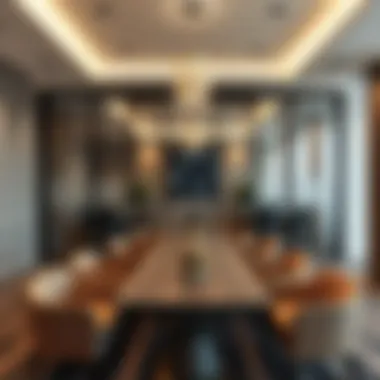
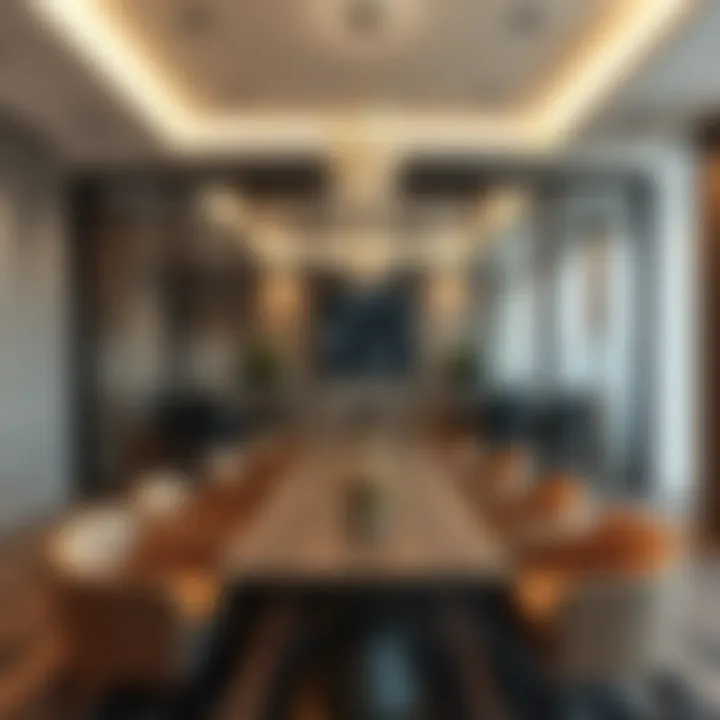
"Understanding building regulations and secure permitting is more than just compliance; it’s about enriching the workspace culture and ensuring a sustainable operational future."
In summary, taking time to fully grasp legal and regulatory considerations influences how efficiently investors and developers can operate in Business Bay. The benefits are not only about avoiding pitfalls; it's about paving the path for optimal space functionality.
Sustainability and Environmental Impacts
Sustainability has become a hot topic in every corner of the globe, and Business Bay is no exception. The urban landscape thrives on innovation and efficiency, yet these must marry sound environmental practices. Partitions, though merely structural elements, can hold significant sway over how we approach sustainability in commercial spaces. They can enhance not only the workspace aesthetics but also contribute positively to the ecological footprint of a building.
Sustainability in the context of partitions encompasses several factors that extend beyond just the materials used. It's about creating a workspace that aligns with modern environmental standards, thereby promoting longevity and reduced environmental impact. For stakeholders like investors, developers, and homebuyers, understanding these elements can be a game changer in making informed decisions.
"The choices made in design can lead to reduced waste, energy efficiency, and a healthier environment for all."
Eco-Friendly Materials for Partitions
The choices we make regarding materials play a crucial role in achieving sustainability. Various eco-friendly options are available for partitions that minimize environmental damage and even promote indoor health. Materials like bamboo, reclaimed wood, or recycled metal stand out for their sustainability credentials. Here’s a rundown of some materials to consider:
- Bamboo: Fast-growing and strictly renewable, bamboo is a robust choice that’s becoming increasingly popular in modern design.
- Recycled Materials: Utilizing reclaimed wood not only offers a rustic charm but also significantly cuts down on waste.
- Low-VOC Paints: When it comes to finishing touches, low volatile organic compounds (VOCs) help ensure that air quality remains high, which is vital for worker health.
Investing in eco-friendly materials doesn’t just fulfill ethical commitments; it can lead to long-term cost savings. Higher-quality materials often last longer, reducing the need for replacements over time.
Long-Term Sustainability Considerations
Being sustainable is not just a one-off effort; it demands long-term planning and consideration. Stakeholders must think ahead. Dilapidated partitions may end up in landfills, but smart design incorporates considerations for future needs and potential upgrades. Here are some factors to consider:
- Lifecycle Assessment: Consider how materials and partitions will perform over time. It’s not simply about the cost upfront, but how they contribute to long-term sustainability within the space.
- Adaptability: The ability to reconfigure spaces effortlessly promotes longevity. A flexible workspace can change in alignment with company needs, significantly reducing waste associated with constant renovations.
- Energy Efficiency: Thoughtful design can incorporate insulating materials or even solar-integrated partitions that can help reduce energy consumption.
Thus, approaching partitions with a long-term sustainability mindset can be beneficial not just for the environment but also for the financial viability of the businesses operating within Business Bay.
For more on sustainable practices in design, visit Wikipedia on Sustainability or check resources from U.S. Green Building Council.
Future Trends in Partition Design
In the bustling environment of Business Bay, the design of commercial spaces is continuously evolving. Future trends in partition design reflect a shift not just in aesthetics but in functionality and adaptability. As workspaces become increasingly dynamic, professionals and businesses are recognizing the pivotal role that innovative partition solutions play in defining how spaces are utilized. This section elucidates the core trends shaping the landscape of partitions and their implications on modern environments.
Technology Integration in Partitions
The integration of technology into partitions has revolutionized the way workspaces function. Smart partitions are not merely barriers; they are evolving into interactive installations that enhance productivity and communication. Features such as built-in screens for presentations or sound-absorbing materials that contribute to a more focused environment are increasingly prevalent.
- Adaptive Technology: Imagine a partition that can adjust its opacity based on the time of day or the level of privacy needed. This technology not only promotes adaptability but also fosters an atmosphere of collaboration where employees can choose their level of openness.
- Acoustic Enhancements: As open office layouts become the norm, sound-related challenges have emerged. New materials used in partitions effectively absorb noise, providing a quieter space for concentration. Businesses are benefiting greatly from having quieter work areas, enhancing worker satisfaction and productivity.
In summary, technology integration in partitions signals a future where flexibility meets functionality. These advancements are not just trends; they represent a necessary evolution in how spaces can support various work styles.
Adapting to Hybrid Workspaces
The rise of hybrid work models has necessitated a rethink of how partitions are utilized. With employees splitting their time between home and the office, the design of workspaces needs to promote not just collaboration, but also focus areas and community spaces that cater to diverse needs.
- Flexible Configurations: Partitions are moving beyond fixed designs; they are becoming modular systems that can be easily reconfigured. This adaptability allows organizations to adjust their layout based on fluctuating team requirements or workplace trends.
- Community Zones: Future designs are also incorporating spaces that foster interaction among team members. Partitions that can be retracted to create open areas help in promoting teamwork while still allowing for individual workspaces when necessary.
“The flexibility of partition designs reflects the changing nature of work. As companies adapt to new norms, their physical spaces must evolve as well.” - Workplace Design Expert
To conclude, the trends in partition design not only respond to the immediate needs of modern workspaces but also anticipate the future demands of businesses. As Business Bay continues to develop, these innovations promise to enhance functionality, encourage collaboration, and provide tailored experiences for all who occupy these spaces.
The End
In wrapping up our exploration of partitions within Business Bay, it’s clear they've become a crucial cog in the machinery of modern workspaces. The role of partitions transcends mere physical barriers; they promote an environment where functionality and aesthetics go hand in hand. As organizations navigate the fast-paced dynamics of urban life, optimizing space through partitions presents numerous advantages.
First and foremost, partitions streamline office layouts, ensuring that every square foot counts. Particularly in a bustling locale like Business Bay — where space often comes at a premium — maximizing floor area can be seen as a make-or-break factor for businesses aiming to adapt and thrive.
Moreover, the benefits extend beyond space efficiency. Enhanced privacy and noise reduction are critical in today's open-plan offices where distractions are lurking at every corner. Employees working in segments defined by partitions can engage deeply with their tasks, yielding better productivity and satisfaction.
When it comes to future trends, the integration of technology into partition systems is revolutionizing the way we visualize spaces. Smart partitions with acoustic properties or those capable of being reconfigured at the touch of a button are no longer confined to the realm of imagination, signaling a shift towards ultra-adaptive work environments.
"A well-partitioned space can be the difference between a chaotic workplace and a harmonious hub of innovation."
Finally, the careful consideration of legal and sustainability aspects cannot be overlooked. Awareness of regulations helps ensure that the implementation of partitions aligns with local building codes while choosing eco-friendly materials plays a pivotal role in the collective effort toward a sustainable future.
With thoughtful design and implementation, the partitions serve a dual purpose — fostering productivity and enhancing the overall aesthetic of the space.



